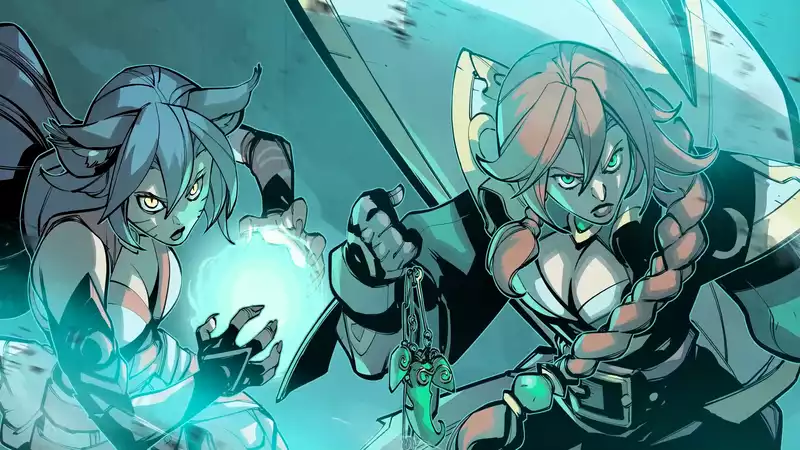Ruined King may look familiar to those who follow fantasy RPGs, not because it's a spin-off of League of Legends, but because it borrows heavily from developer Airship Syndicate's Battle Chasers Ruined King is another isometric RPG with a turn-based battle system and unmistakable artwork by Joe Madureira Ruined King also has a fishing mini-game and a somewhat Zelda-like dungeons. If you've played Battle Chasers before, you'll feel right at home. Those who came from League of Legends may need a more detailed explanation.
Basically, LoL champs Miss Fortune, Illaoi, Braum, and a few others team up to try to save the city of Bilgewater from the usual deadly fantasy mists. Before fate brought the gang together, each of them happened to be in Bilgewater on unrelated business. Former Bilgewater tyrant Gangplank, another LoL champion, has a history of murder with Miss Fortune and a love affair with the Kraken priestess Ilaoi.
There is nothing more to Ruined King's story than that. The setting is barely touched upon, and the characters are cemented in archetypes. Sarah Fortune is a hot-blooded, headstrong pirate captain, Buraom is a lovable muscle-bound, and Yasuo is a disgraced samurai seeking redemption. Ilaoi deserves more attention, a muscular priestess who strikes down her enemies with a giant golden idol. Still, most of these characters you have probably seen in other RPGs or fantasy novels.
That is not necessarily a criticism. And the cast of The Ruined King is an interesting bunch as a whole. They are so cartoonish and larger than life that I feel like I already knew them, despite my lack of knowledge of the game this spun off. That's partly because they're based on archetypes, but also because they're vividly recreated and brought to life with snappy little party interactions and especially juicy turn-based combat.
More on this later, but on a basic level, watching the champs and villains fight in Final Fantasy-like side-on style battles is a joy to watch. As in "Battle Chasers," the animation in this game is fluid and expressive. Whether it's a basic attack, a huge boss blow, or a flashy limit break that each character will soon be able to use. If the story is lean and you spend little time on trivial world-building or character development, you can learn about your heroes by watching Sarah Fortune juggle a flintlock gun or Ilaoi throw her idols like heavy bowling balls.
Especially impressive.
Particularly impressive are the bosses' animations, which make the camera zoom out wide to accommodate them. With respawning minions and very specific combat conditions, they are enemies that take full advantage of the Ruined King's complex combat system, including buffs, debuffs, synergies, and timeline management.
JRPG fans will be familiar with games that use combat timelines, such as Final Fantasy X. Ruined King builds on this concept by turning timelines into lanes, a term borrowed from LoL.
The icons on the lanes (shown at the bottom of the screen) are small and indistinct, and the menus are not intuitive, so it took me a while to understand this system. For example, if you want your buddy Yasuo to get ahead of that pirate, you can use an ability that pushes the enemy back along the lane. The ability has an activation time, so it may not trigger immediately. The enemy may kill the wounded fighter before your heal spell is activated.
If it all sounds perfectly reasonable, that's because I've only told half the story. There are also environmental wildcard effects that can affect each battle positively or negatively. For example, like a sniper shooting at you while you are exploring a dungeon. However, effects such as poison and recovery are also randomly assigned by the game. Wildcards are ultimately triggered by someone landing in a box located on the timeline, giving further reason to send participants back and forth.
The lane system is innovative and adds another layer of complexity to an already robust battle system. I just wish they would have stopped with such a laborious implementation.
Ruined King is not keen on the mindless filler battles that are so common in this genre, so you have to put your all into the combat. That's great in a way - what's the point of a one-sided battle - but the relentless pace makes the fight quite exhausting.
While combat is clearly the heart of the game, there is a compact town around which you can enjoy side quests, bounty hunting, and even some heartwarming fishing. Of course, half of the game will be spent in the menus, creating enchantments and switching character upgrades. Everything one would expect from a turn-based RPG is faithfully and skillfully represented in this game.
Just not very exciting. There are few elements that will surprise you. Ultimately, much of the game feels like content that's just League of Legends overlaid on League of Legends.
Why the story didn't grab me is that I didn't have time to care about the characters or the fate of their world. This is CliffsNotes' take on RPGs: exciting and electrifyingly paced, but it feels like it starts about halfway through the adventure.
Flashbacks fill in the gaps, but not enough to immerse you in the world. Those already familiar with the characters and setting of "League of Legends" will get more out of "Ruined King.
.

Comments